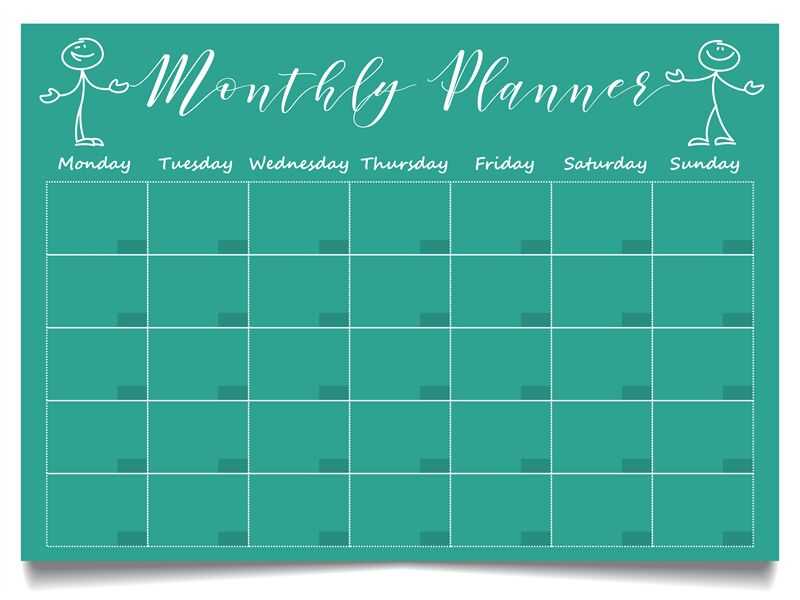
Effective planning can transform the way you approach cooking and eating throughout the month. By mapping out meals in advance, you create a clear structure that minimizes decision fatigue and makes grocery shopping more efficient. This method is not just about saving time; it’s about creating balance in your diet, reducing food waste, and bringing variety to your daily dishes.
Having a structured approach to planning your daily and weekly food choices also allows you to experiment with new recipes, incorporate seasonal ingredients, and ensure that you’re meeting your nutritional needs without the stress of last-minute planning. Whether you’re cooking for yourself or for a family, the benefits of this method are far-reaching, making meal preparation a simpler and more enjoyable task.
With the right tools, it becomes easier than ever to keep track of what you’ve planned and when. An organized visual guide helps to see everything at a glance, so you can adjust when needed without disrupting the overall flow. This system brings both convenience and flexibility, ensuring that you’re always prepared, no matter what the month brings.
How to Create a Monthly Menu Calendar
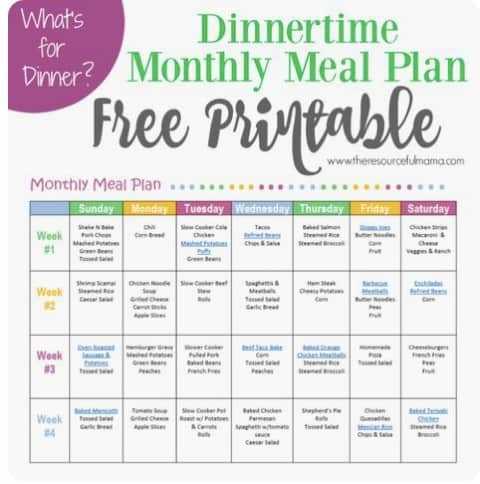
Planning your meals in advance can save time, reduce stress, and help maintain a balanced diet. By organizing your food choices for each day, you can streamline grocery shopping, avoid last-minute decisions, and ensure variety throughout the week. Crafting a visual representation of your meals for the upcoming period allows for better preparation and healthier eating habits.
To begin, select a method to lay out your plan. Whether using a physical board, an app, or a simple digital document, choose a format that is easy for you to manage. Start by allocating each day of the week with a specific dish or meal type, considering your family’s preferences, dietary restrictions, and available ingredients. Ensure there is a mix of proteins, vegetables, and grains throughout the period to maintain nutritional balance.
Next, make a detailed list of ingredients required for each dish. This can be helpful for creating a shopping list that aligns with your schedule. Consider bulk-buying non-perishable items in advance to minimize weekly trips to the store. It’s also advisable to account for leftovers and prepare dishes that can be used for multiple meals.
Lastly, keep the plan flexible. Life can be unpredictable, and having the ability to swap meals between days is crucial. Incorporating some buffer days for easy-to-make or leftover meals allows for adaptation when needed. Reviewing your plan regularly will help you stay on track and adjust as necessary.
Benefits of Using a Meal Planner
Organizing your meals in advance offers numerous advantages, from saving time to improving your overall well-being. By planning your daily dishes ahead of time, you can reduce stress and make better food choices, ensuring a balanced and nutritious diet. Such preparation helps streamline grocery shopping and eliminates last-minute decisions that often lead to unhealthy options.
Time Efficiency: One of the most noticeable benefits of planning your meals is the amount of time saved. By knowing exactly what to cook each day, you avoid the need to figure out meals in the midst of a busy schedule. This can free up precious moments to focus on other important tasks or enjoy leisure activities.
Cost Savings: Planning your meals helps you buy ingredients in bulk and reduce impulse purchases, ultimately lowering your grocery bill. It allows you to make the most of what you already have in your kitchen, preventing food waste and ensuring that nothing goes unused.
Healthier Choices: When meals are planned thoughtfully, there is a greater opportunity to include a variety of healthy foods. This reduces the likelihood of relying on processed or takeout options, which can often be higher in calories, fats, and sodium.
Consistency: Meal planning fosters consistency in your eating habits. Whether you are aiming for specific fitness goals or simply wish to maintain a balanced lifestyle, having a structured approach ensures that you’re consistently meeting your nutritional needs and avoiding unplanned indulgences.
Choosing the Right Template for Your Needs
When planning your daily or weekly organization, finding the right layout can make all the difference. Whether you’re managing a project, planning meals, or scheduling events, selecting the appropriate format is crucial for efficiency and clarity. The layout you choose should reflect the scope and frequency of your tasks while accommodating your style and preferences.
Key Considerations for Selection
Before diving into the options available, it’s important to evaluate your specific needs. Different designs are suited for various purposes, and understanding your goals will help you narrow down the choices.
- Frequency of Updates: If your tasks change frequently, a more flexible structure with enough space for daily modifications may be needed.
- Visual Clarity: Ensure the layout you select provides enough space for details, while remaining easy to read and navigate at a glance.
- Organization Method: Whether you prefer a structured, grid-based format or something more free-flowing, the layout should match how you think and plan.
- Style Preferences: Choose a design that complements your personal or professional aesthetic, helping you stay motivated and engaged with your planning.
Types of Layouts to Consider
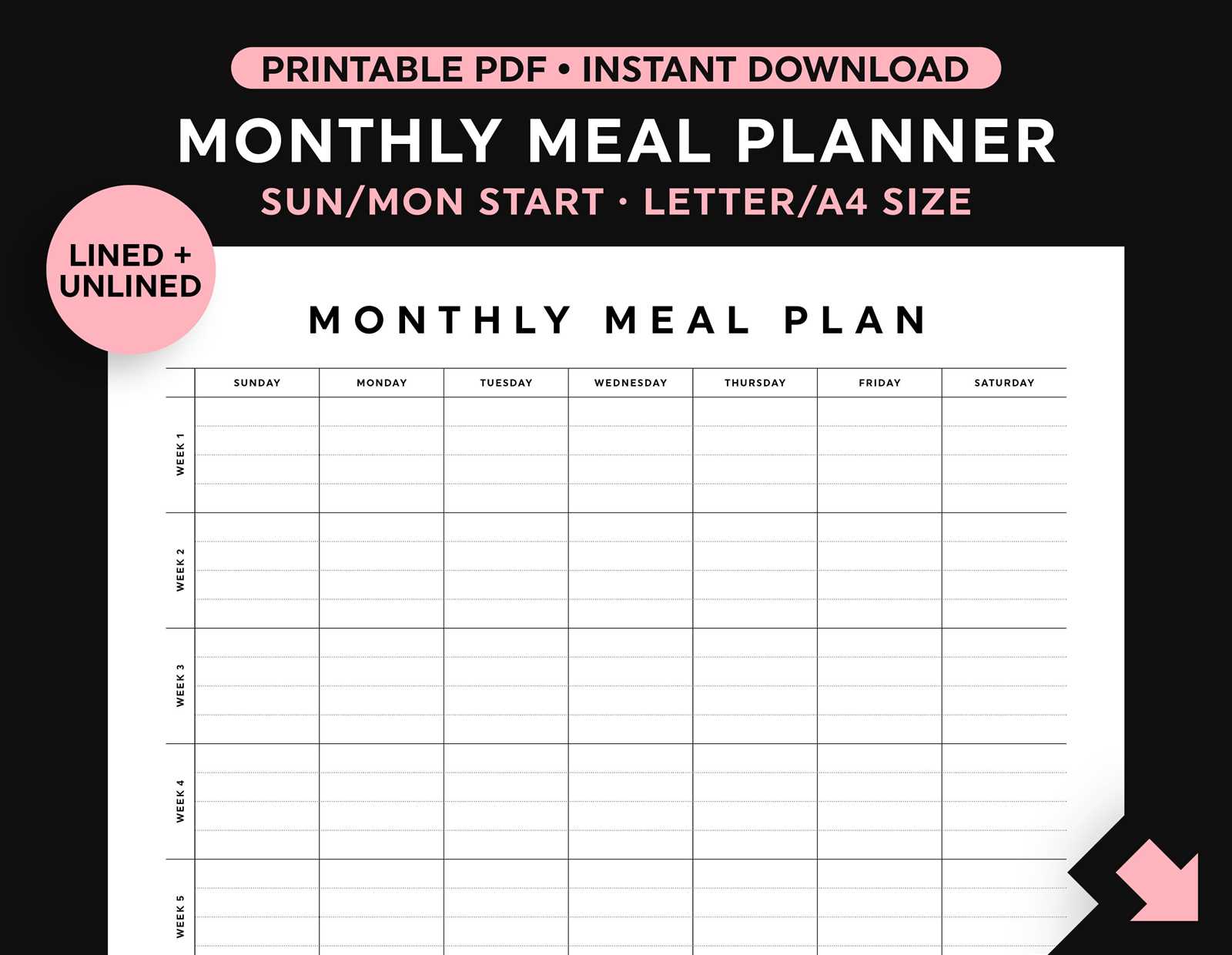
There are a variety of structures available, each offering its own advantages. Here are a few examples:
- Grid-Based Designs: Great for those who need clear distinctions between each section or day. Ideal for time management tasks.
- List-Based Formats: Perfect for simple task tracking or minimalistic approaches where you only need to focus on key activities.
- Flexible Systems: Useful for those who require adaptability, offering blank spaces and sections that can be customized as needed.
- Visual Planners: These layouts integrate images, color coding, or symbols to help visually organize tasks and priorities.
Ultimately, the right format depends on your needs and the way you work best. Consider your goals, time constraints, and visual preferences to find the most suitable option.
Customizing Your Monthly Calendar Layout
Designing a layout that suits your specific needs involves adapting the structure to fit your preferences. By adjusting key elements, you can ensure the display is as functional and visually appealing as possible. Whether it’s for tracking events, appointments, or special activities, a personalized approach can help streamline the process and make it more intuitive.
One of the first things to consider is the grid organization. You can modify the number of columns or rows, allowing for more or less space depending on your requirements. For example, if you need extra room for notes or additional details, expanding each section is a practical choice. Conversely, for a more compact layout, you can reduce the size of individual blocks.
Color schemes are another important factor in customization. Bright hues can make your schedule more energetic and easy to navigate, while muted tones create a calmer, more understated feel. You can choose colors to highlight specific types of events, such as meetings in blue and personal time in green, or create an entirely unique color-coding system that fits your preferences.
Another key element is adding special sections or features that cater to your unique needs. You might want to include a small area for to-do lists, a notes section, or even inspirational quotes to stay motivated throughout the period. Integrating these personalized elements helps transform the structure from a simple tool into a more holistic resource.
Finally, consider incorporating interactive elements if you plan to use a digital version. Features such as drag-and-drop functionality, reminders, and clickable links can further enhance the user experience. This flexibility ensures that your layout not only looks good but is also practical and easy to interact with.
How to Organize Recipes Efficiently
Effective organization is key to simplifying the process of planning meals and maintaining a smooth kitchen workflow. A well-structured system allows you to easily locate the dishes you want to prepare, reducing stress and saving time. Whether you’re cooking for one or many, having a clear method of managing your culinary ideas can bring a sense of order and creativity to your kitchen routine.
1. Categorize Your Dishes
Start by grouping your recipes into categories that make sense for your needs. You can sort them by type of cuisine, meal type (breakfast, lunch, dinner), or even by main ingredient. This helps in quickly finding something that suits your current preferences or dietary restrictions. For example, keeping all vegetarian recipes together, or separating desserts from main courses, can cut down on decision-making time.
2. Use Digital Tools for Quick Access
Leverage technology to keep track of your culinary collection. There are many apps and platforms that allow you to store and organize your recipes in an easily accessible way. Tagging recipes with keywords such as “quick,” “healthy,” or “family-friendly” can help narrow down options based on your current needs. Digital storage also makes it simpler to update and share recipes with others.
Additional Tip: Keep a backup of your recipes by saving them both online and offline to avoid losing your favorite dishes due to technical issues.
Time-Saving Tips for Meal Planning
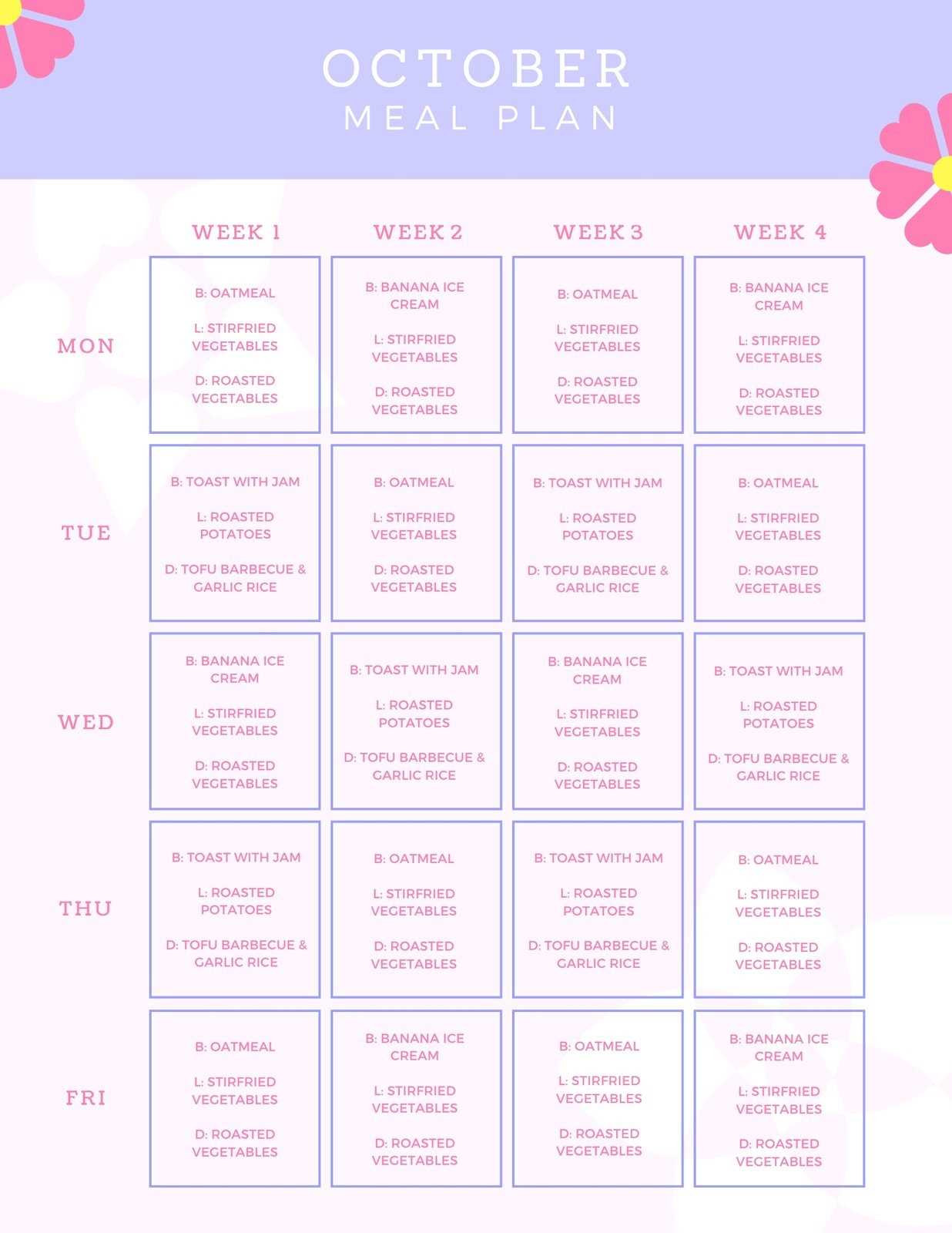
Organizing your meals ahead of time can significantly reduce stress and save you valuable time during busy weeks. By making a few simple adjustments to how you approach cooking, you can streamline your process and ensure healthier, more efficient meals without the daily hassle.
1. Plan in Batches
Cooking in larger quantities is one of the most effective ways to save time. Instead of preparing a meal every day, dedicate some time each week to cook in bulk. This allows you to store leftovers for future meals, reducing both the time and effort required throughout the week.
2. Keep It Simple
Opt for recipes that require minimal ingredients and preparation. Complex dishes may seem appealing, but they can consume unnecessary time. Focus on meals that are quick to make but still nutritious, such as one-pot dishes or sheet-pan meals.
3. Prep Ingredients Ahead of Time
Spend some time chopping vegetables, marinating meats, or measuring out dry ingredients. This can be done either the night before or earlier in the week, so when it’s time to cook, all the components are ready to go.
4. Embrace Leftovers
Don’t underestimate the power of leftovers. Preparing a larger portion for dinner one night can provide lunch or dinner for the next day, saving you from having to cook from scratch every time.
5. Invest in Time-Saving Appliances
Using tools like slow cookers, pressure cookers, or air fryers can greatly reduce cooking time. These appliances allow you to throw in ingredients and let them cook while you focus on other tasks.
6. Make Use of Freezer-Friendly Meals
Freezing portions of meals for later is an excellent way to save time. When you’re ready to eat, simply defrost and reheat, and you’ll have a delicious, homemade meal in minutes.
7. Keep a Rotating List of Go-To Recipes
Having a collection of reliable recipes that you can rotate regularly will save time spent searching for new ideas. Choose meals that require ingredients you often have on hand to simplify grocery shopping and reduce decision fatigue.
By integrating these strategies into your weekly routine, you can save time, reduce stress, and enjoy more home-cooked meals with less effort. The key is consistency and planning ahead–small efforts in advance can make a big difference when it’s time to cook.
Meal Prepping: Key to Success

Planning and preparing meals ahead of time is a powerful approach to ensuring balanced nutrition and saving valuable time throughout the week. By organizing ingredients and dishes in advance, it becomes easier to stay on track with health goals and avoid last-minute unhealthy choices. A well-prepared strategy can make all the difference when it comes to maintaining consistency and achieving long-term success.
Meal prepping is more than just cooking in bulk; it’s about understanding your needs, preferences, and the best ways to align your eating habits with your lifestyle. Whether you’re aiming to lose weight, save time, or improve overall well-being, prepping allows for control over both portions and quality.
The key to mastering this approach lies in thoughtful organization and a willingness to commit to the process. When each meal is ready to go, you remove the stress of decision-making and the temptation of fast food, which often leads to poor dietary choices. The ultimate goal is not only convenience but also a more balanced, fulfilling way of living.
Incorporating Seasonal Ingredients into Menus
Utilizing ingredients that align with the changing seasons not only enhances the flavor and nutritional value of dishes but also connects diners with the natural cycle of food production. When ingredients are sourced at their peak, they offer a richer taste profile and a more sustainable approach to sourcing. This approach allows chefs to highlight the best that each season has to offer while ensuring that the ingredients are at their freshest and most flavorful.
Why Seasonal Ingredients Matter
Seasonal produce is often fresher and more affordable, as it doesn’t require long-distance transportation or expensive storage methods. Additionally, many seasonal ingredients are packed with nutrients that are vital for health during specific times of the year. For example, root vegetables and hearty greens are perfect for colder months, providing the body with the energy it needs to stay warm. In contrast, light fruits and fresh herbs shine during the warmer months, offering refreshing and hydrating options.
Ways to Incorporate Seasonal Ingredients
- Adjust Recipes with Seasonal Produce: Swap out ingredients based on what’s in season. For example, use squash or pumpkins in the fall and fresh berries in the summer.
- Highlight Local Varieties: Focus on regional produce that is abundant at a particular time of year. This ensures maximum freshness and supports local farmers.
- Use Seasonal Herbs: Add herbs like basil in the summer and rosemary or thyme in the winter to complement main dishes.
- Offer a Special for Each Season: Introduce unique dishes or desserts that celebrate the specific flavors of each season, such as a pumpkin spice treat in the fall or a refreshing citrus salad in the spring.
- Plan for Preservation: For months when certain items are in excess, consider preserving them for later use, such as pickling, canning, or freezing fruits and vegetables.
Embracing seasonal ingredients not only elevates the dining experience but also fosters a deeper connection between food and the environment. By embracing the rhythm of nature’s bounty, each dish can become a celebration of the time of year it was crafted in.
Budget-Friendly Meal Planning Strategies
Organizing your meals in advance can significantly reduce both time spent on preparation and overall food expenses. By thinking ahead, you can optimize what you already have, limit food waste, and avoid unnecessary purchases. The key is to plan smartly, choose versatile ingredients, and make use of bulk buying where possible. With a little thought and effort, it’s possible to enjoy nutritious, tasty dishes without breaking the bank.
Utilizing Staples and Leftovers
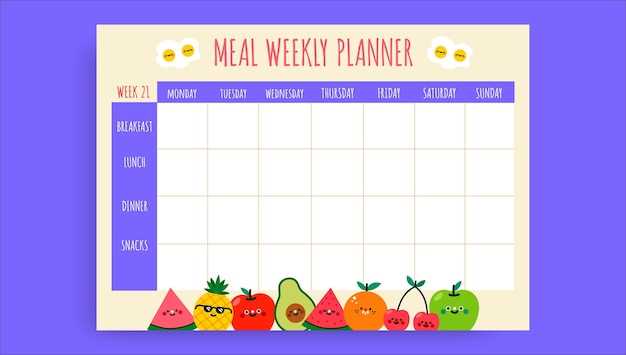
One of the most effective ways to save money is by incorporating pantry staples such as rice, beans, and pasta. These ingredients are not only affordable but also adaptable to many different recipes. Additionally, reimagining leftovers into new meals can help stretch your food budget even further, reducing the need to buy extra ingredients every week.
Seasonal and Local Ingredients
Purchasing produce that is in season or locally grown is a great strategy for lowering costs. Not only are these ingredients often fresher and tastier, but they are usually more affordable compared to imported or out-of-season options. Focus on fruits and vegetables that are abundant during a particular time of year to get the best value for your money.
Balancing Nutritional Needs in Your Menu
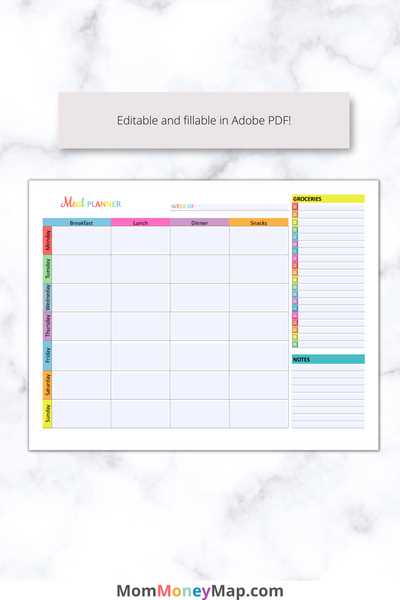
When planning meals for a group or family, it’s crucial to ensure that each dish offers a variety of essential nutrients. A well-rounded plan can support energy levels, promote health, and maintain well-being. The goal is to strike a harmonious balance between proteins, fats, carbohydrates, vitamins, and minerals, while also considering individual preferences and dietary restrictions.
Incorporating a wide range of foods is key. Each food group provides unique benefits, from lean meats and legumes rich in protein to fruits and vegetables full of fiber, vitamins, and antioxidants. Including whole grains alongside healthy fats can help balance blood sugar and support heart health. Additionally, variety ensures that you cover all the necessary micronutrients, which are just as important as macronutrients in daily functions.
Consideration should also be given to portions and preparation methods. Moderation in portions and healthy cooking techniques, like grilling or steaming, can maximize nutrient retention and minimize excess calories or fats. The ultimate objective is not only to satisfy hunger but to nourish the body efficiently.
Designing a Family-Friendly Meal Calendar
Creating a practical and balanced meal schedule that suits the diverse needs of every family member can make a significant difference in your daily routine. The key is to establish a flexible structure that incorporates nutritious and enjoyable dishes while minimizing stress in the kitchen. With a well-organized approach, you’ll ensure that every day brings something new, while also saving time on planning and shopping.
Prioritize Variety and Nutrition
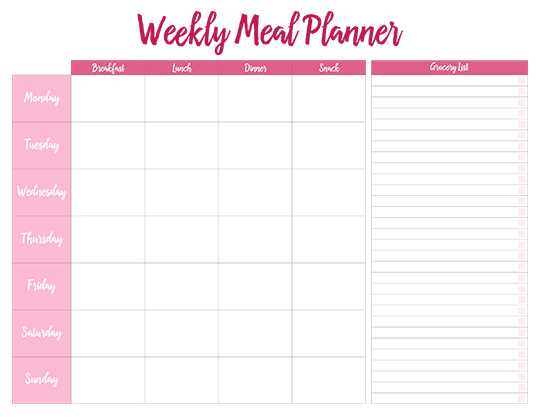
To maintain a healthy and engaging eating routine, it’s essential to offer a range of flavors, textures, and nutritional benefits. Rotate between different food groups such as vegetables, proteins, and grains, ensuring that each meal is both satisfying and well-balanced. For example, introduce new dishes each week to keep mealtime interesting, while also including family favorites that everyone enjoys.
Incorporate Easy-to-Prepare Dishes
While creativity is important, simplicity also matters. Select meals that are easy to prepare on busy days and require minimal ingredients. One-pot dishes, sheet-pan meals, and slow-cooker options are great choices for those evenings when time is tight. These dishes save both effort and cleanup time, allowing the family to focus on quality time together instead of spending hours in the kitchen.
Remember, planning ahead and adapting to your family’s preferences is the foundation of creating a successful eating routine. Keep it flexible, fun, and practical!
How to Manage Special Diets and Preferences

When planning meals for a group, it’s essential to consider the varying nutritional needs and personal preferences of individuals. Accommodating different dietary restrictions and tastes can be a challenge, but with the right approach, it becomes much easier to ensure everyone’s satisfaction and well-being. Careful planning and flexibility are key to successfully managing these unique requirements.
Understand Specific Requirements
Before creating a meal plan, take the time to gather detailed information about each individual’s specific dietary needs. Whether it’s due to health concerns, food sensitivities, or lifestyle choices, understanding these preferences allows for the creation of balanced and suitable meals. Allergies, intolerances, and ethical considerations like vegetarianism or veganism should always be taken into account when preparing food for diverse groups.
Provide Variety and Flexibility
Once you’ve identified the key preferences and restrictions, aim to offer a variety of options that cater to everyone. This may involve preparing several dishes for each meal, ensuring there is something for those with specific dietary needs while still keeping the meals interesting and diverse for everyone. Flexibility in your planning can also help to adapt to last-minute changes, ensuring that no one feels excluded from enjoying delicious and nutritious meals.
Printable vs. Digital Meal Planning Options
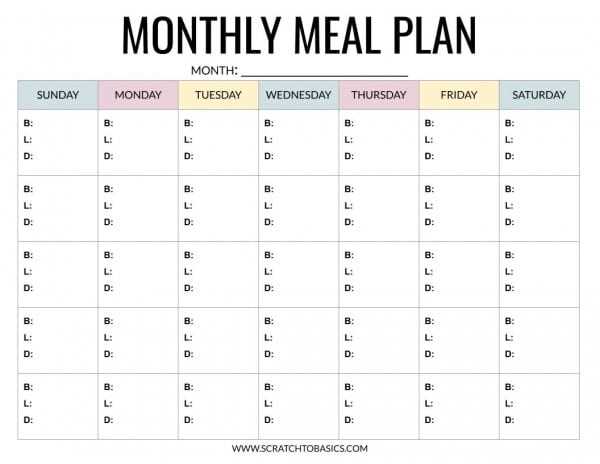
When organizing meals for the week or month, many people choose between physical and digital solutions. Both approaches offer distinct advantages depending on your preferences and lifestyle. Some prefer the tactile nature of printed materials, while others enjoy the convenience and flexibility of digital formats. Understanding the strengths of each method can help you decide which best fits your needs for meal organization.
Benefits of Printed Meal Organizers
Printed planners provide a tangible way to keep track of your meals. Once you’ve created your layout, you can place it on the fridge or wall, making it highly visible and easy for everyone in the household to follow. It’s an excellent option for those who enjoy a more hands-on approach, where you can write down ideas, cross off completed tasks, and even make quick adjustments as necessary.
Advantages of Digital Organizers
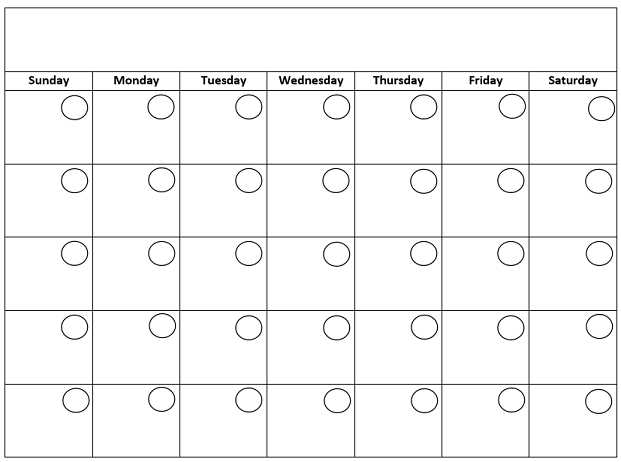
On the other hand, digital planners offer flexibility and easy accessibility. With cloud synchronization, you can access your planning tool from any device, whether at home, at work, or on the go. Many digital options also come with interactive features such as shopping lists, meal reminders, and integration with grocery delivery services, simplifying the process even further.
| Feature | Printed Option | Digital Option |
|---|---|---|
| Accessibility | Requires physical access to the planner | Accessible from multiple devices, anywhere |
| Customization | Can be written or drawn on | Multiple customization options with templates |
| Eco-friendliness | Paper-based, potentially wasteful | Environmentally friendly, no paper waste |
| Ease of Use | Simple, no tech skills required | Requires device and familiarity with software |
How to Track Grocery Shopping with a Calendar
Keeping track of your grocery shopping can be a challenge, especially when trying to stick to a budget, avoid unnecessary trips to the store, or plan meals efficiently. One effective way to stay organized is by using a structured system to record and monitor purchases. This approach helps not only streamline your shopping habits but also ensures that you are consistently stocked with essential items without overbuying. By utilizing a visual tool, you can manage your grocery list more effectively, reduce waste, and save time during shopping trips.
Here are some ways to incorporate a tracking system into your routine:
- Set specific days for shopping: Mark the days of the week when you’ll make trips to the store. This helps in establishing a rhythm and prevents last-minute runs for forgotten items.
- Plan ahead for essential items: Identify staple products you’ll need throughout the week or month and make a list of them in advance. Regularly check your inventory at home to ensure you’re not duplicating purchases.
- Track sales and promotions: Use your system to jot down when certain items are on sale, and plan your shopping trips around these dates to save money.
- Record purchases and meal ingredients: After each shopping trip, write down the items you’ve bought. This helps avoid buying the same ingredients repeatedly and ensures you use up what you already have before purchasing more.
By keeping a detailed schedule, you can make grocery shopping an easier and more efficient task, reducing unnecessary stress and improving your overall meal planning strategy.
Making the Most of Leftovers
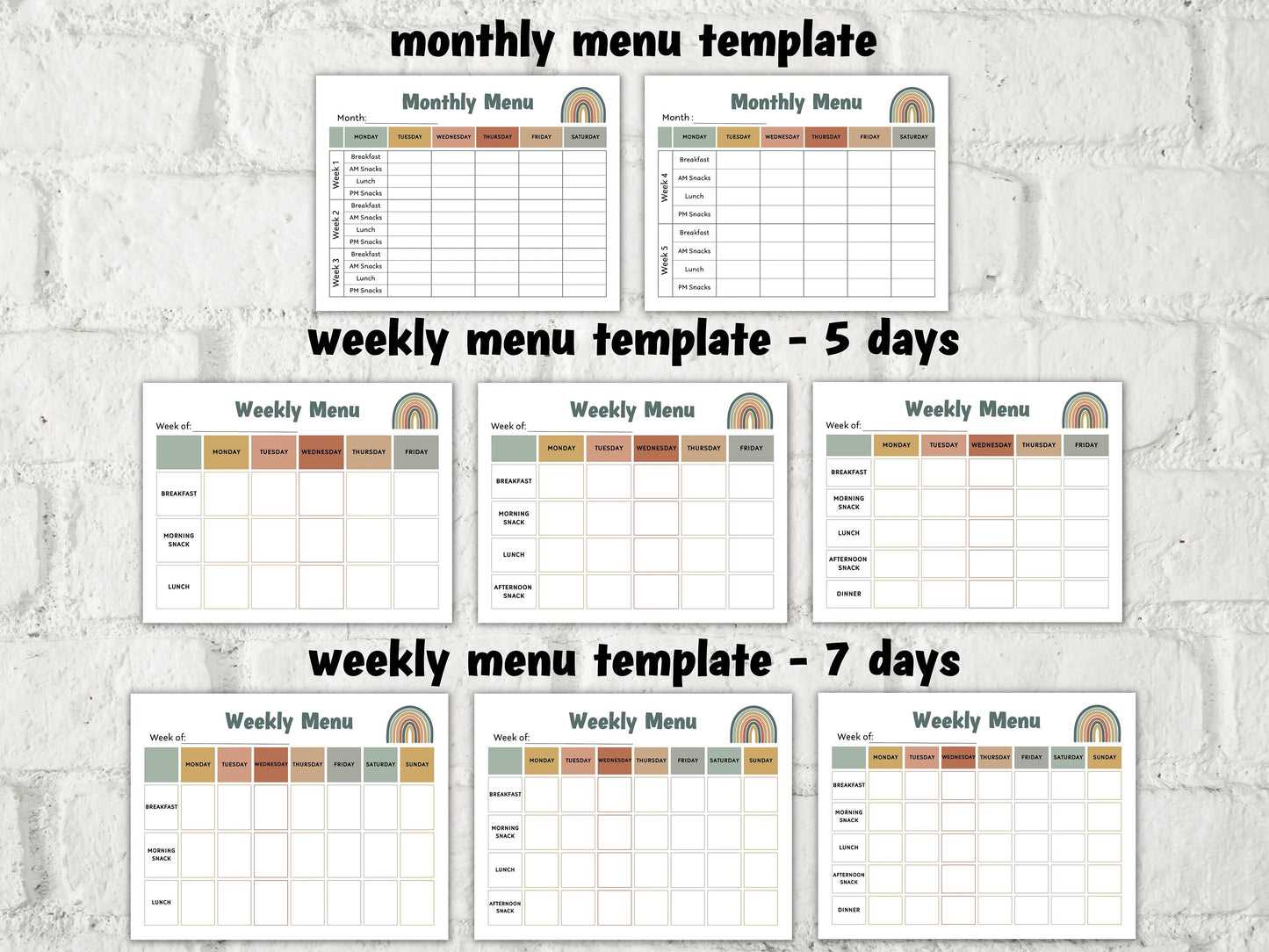
Leftovers often have the potential to be more than just a quick meal for the next day. With a little creativity, they can be transformed into delicious and exciting dishes that make the most of what’s already been prepared. By rethinking how we use what remains from previous meals, we can reduce waste, save time, and create new meals with minimal effort.
Creative Ways to Repurpose Leftovers
One of the simplest ways to repurpose leftovers is by incorporating them into entirely new recipes. For example, roast vegetables from dinner can easily become the base for a hearty soup or stew. Grilled meats can be shredded and added to salads, tacos, or wraps. Even cooked grains, like rice or quinoa, can be combined with fresh ingredients to create a wholesome grain bowl.
Quick and Tasty Ideas
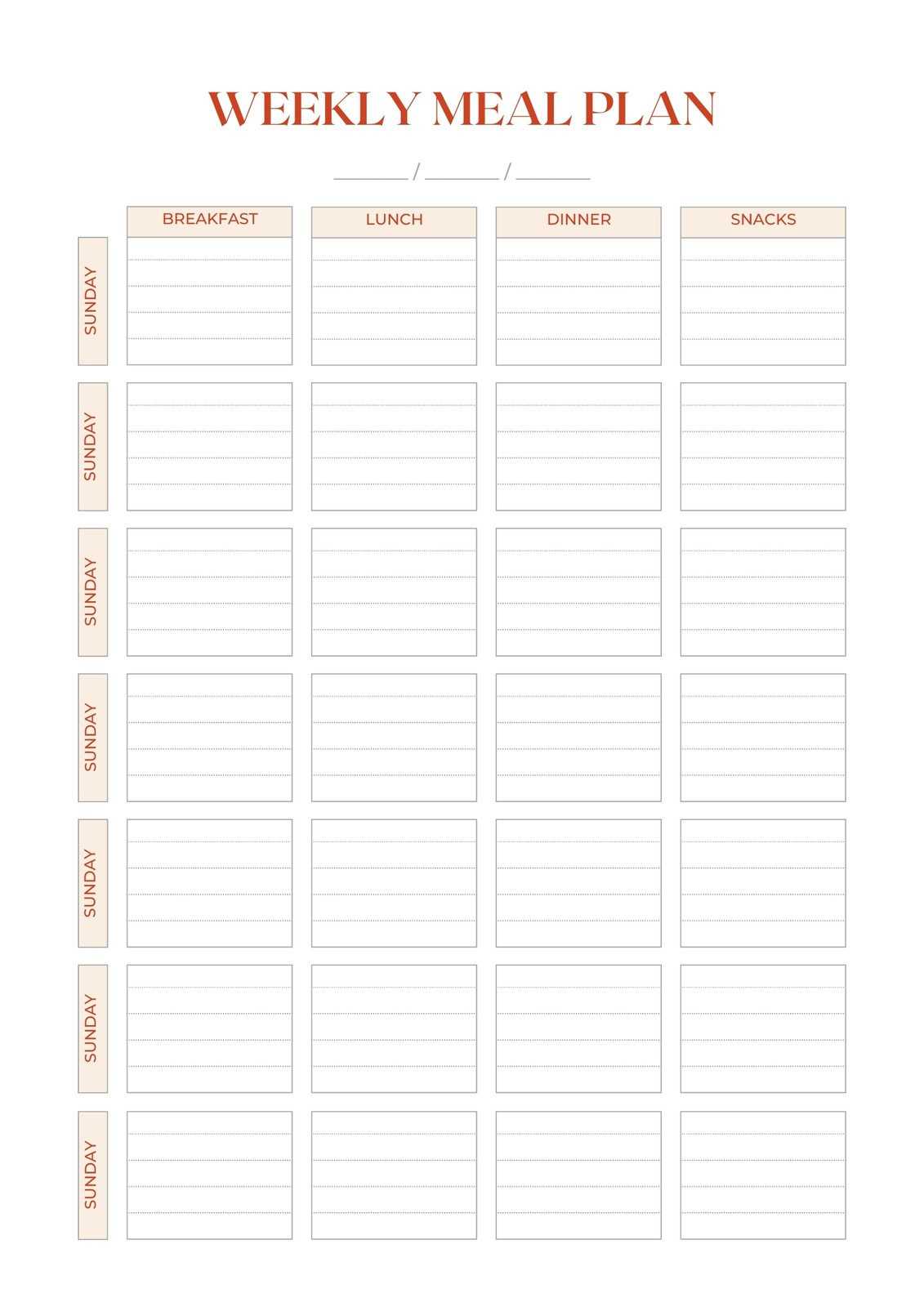
Sometimes, all it takes is a little seasoning or a few fresh additions to turn yesterday’s meal into something entirely different. Adding a new sauce or dressing, or mixing leftovers into a stir-fry with fresh veggies, can instantly breathe new life into a dish. Don’t forget to experiment with spices and herbs to create flavors that feel completely different from the original meal.
By thinking outside the box, leftovers can be the starting point for an entirely new culinary adventure, reducing food waste while offering new flavors and textures with little extra effort.
Using a Menu Calendar for Special Events
Planning meals for special occasions can be overwhelming, but having a structured approach can simplify the process. By organizing dishes in advance, you ensure that everything is prepared in a timely manner and that no important details are overlooked. A well-thought-out schedule helps in coordinating different courses, accommodating dietary preferences, and aligning flavors with the theme of the event.
For instance, when hosting a celebration, it’s crucial to plan not only the main dishes but also the appetizers, sides, and desserts. Creating a clear outline allows for an effective shopping list and ensures that nothing is forgotten. By setting aside specific days for preparation and cooking, you reduce stress and create a smoother, more enjoyable experience for both the host and the guests.
Customized meal planning also provides flexibility. You can tailor the selection to match any special requirements, whether it’s vegetarian, gluten-free, or based on cultural preferences. Additionally, organizing meals according to timeframes and expected guest numbers ensures that everything is fresh and appropriately portioned.
Ultimately, organizing a sequence of meals ahead of time empowers you to focus on other aspects of the event, from decoration to entertainment. Whether it’s a small gathering or a large party, having a clear guide for what will be served elevates the experience and provides peace of mind.
How to Stay Consistent with Your Meal Plans
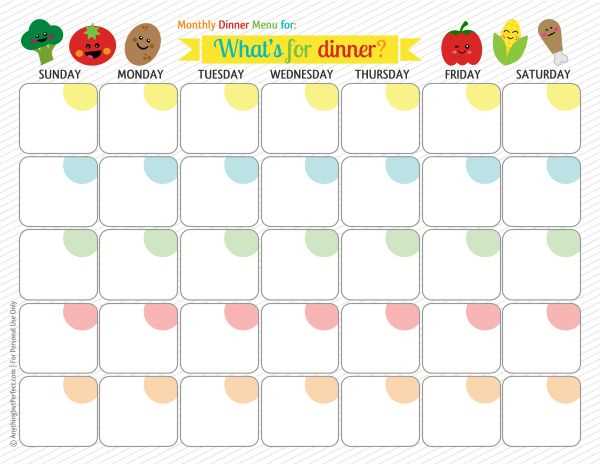
Maintaining a steady routine with your food choices can be challenging, but it’s essential for achieving long-term health goals. The key to consistency lies in preparation, flexibility, and tracking progress. By creating a clear structure and sticking to it, you can avoid stress around mealtime and ensure you’re nourishing your body in the best possible way.
Here are some practical tips to help you stay on track:
- Plan Ahead: Taking the time to decide what you’ll eat in advance reduces the chance of impulse decisions. A weekly food strategy can help you make informed grocery choices and streamline your cooking process.
- Keep it Simple: Don’t overcomplicate your meals. Focus on quick, healthy, and easy-to-prepare dishes that you enjoy. This will prevent burnout and help you stick to your goals.
- Batch Cook: Preparing meals in bulk can save time and ensure that you always have a nutritious option available. Store meals in containers for easy access throughout the week.
- Stay Flexible: Life can get busy, and sometimes you’ll need to adjust your plans. Be open to switching meals around without feeling guilty, as long as you’re still making healthy choices.
- Track Your Progress: Keeping a food journal or using an app to track your meals can help you stay focused. It allows you to monitor your consistency and make adjustments if necessary.
- Get Creative: Experiment with new recipes and flavors to keep things interesting. A little variety can make your food routine more enjoyable and less monotonous.
By following these steps and staying disciplined, you can form lasting habits that align with your health and wellness objectives. Consistency doesn’t mean perfection–it’s about making mindful choices and being committed to your long-term goals.
Common Mistakes to Avoid in Meal Planning
When organizing your meals, it’s easy to overlook certain details that can affect the overall balance and efficiency of your approach. Making a plan may seem straightforward, but poor decisions can lead to wasted resources, nutritional imbalances, and unnecessary stress. Avoiding some common pitfalls will help streamline the process and make meal preparation much more effective.
1. Lack of Variety
One of the most frequent mistakes is sticking to the same dishes over and over. This can result in boredom and a lack of essential nutrients. It’s important to incorporate a wide range of ingredients and recipes to keep your meals exciting and nutritionally diverse. Experimenting with different cuisines and ingredients can also prevent you from feeling stuck in a routine.
2. Overcomplicating the Process
Sometimes, the desire to create elaborate meals leads to unnecessary complexity. While creativity in the kitchen is great, overly complicated plans can be exhausting and time-consuming. Focus on meals that are simple yet satisfying, and try to limit the number of ingredients or steps required, especially on busy days.
3. Ignoring Time Constraints
Failing to account for your available time can make meal preparation stressful. A plan that doesn’t consider how much time you have to cook or eat can lead to rushed, unsatisfying meals. It’s crucial to match the complexity of your meals to the amount of time you can realistically dedicate to cooking, especially during the week.
4. Not Considering Personal Preferences or Dietary Needs
Forgetting to take into account the preferences and dietary restrictions of everyone involved can lead to waste and dissatisfaction. Ensure that your plan accommodates individual needs, whether it’s for allergies, preferences, or specific dietary goals. This attention to detail will ensure everyone enjoys the meals and reduces the likelihood of leftovers going unused.
5. Failing to Plan for Leftovers
Many people neglect to think about how leftovers will be used, which can lead to unnecessary food waste. Planning ahead to repurpose or store leftovers in creative ways can save time, reduce waste, and prevent additional grocery runs. Leftovers can be an excellent source of quick meals later in the week.
By being mindful of these common mistakes, you can make your meal preparation more efficient, enjoyable, and sustainable in the long run.